Related Research Articles

Alfred Bryan was a Canadian lyricist.
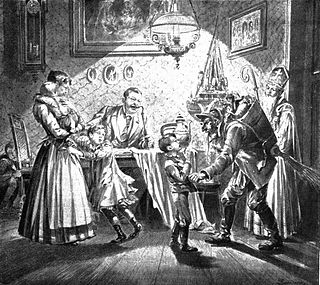
The companions of Saint Nicholas are a group of closely related figures who accompany Saint Nicholas throughout the territories formerly in the Holy Roman Empire or the countries that it influenced culturally. These characters act as a foil to the benevolent Christmas gift-bringer, threatening to thrash or abduct disobedient children. Jacob Grimm associated this character with the pre-Christian house spirit which could be benevolent or malicious, but whose mischievous side was emphasized after Christianization. The association of the Christmas gift-bringer with elves has parallels in English and Scandinavian folklore, and is ultimately and remotely connected to the Christmas elf in modern American folklore.

The "Battle Cry of Freedom", also known as "Rally 'Round the Flag", is a song written in 1862 by American composer George Frederick Root (1820–1895) during the American Civil War. A patriotic song advocating the causes of Unionism and abolitionism, it became so popular that composer H. L. Schreiner and lyricist W. H. Barnes adapted it for the Confederacy.
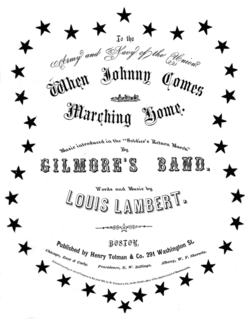
"When Johnny Comes Marching Home", sometimes "When Johnny Comes Marching Home Again", is a popular song from the American Civil War that expressed people's longing for the return of their friends and relatives who were fighting in the war.

"The Bonnie Blue Flag", also known as "We Are a Band of Brothers", is an 1861 marching song associated with the Confederate States of America. The words were written by the entertainer Harry McCarthy, with the melody taken from the song "The Irish Jaunting Car". The song's title refers to the unofficial first flag of the Confederacy, the Bonnie Blue Flag. The left flag on the sheet-music is the Bonnie Blue Flag.

Mickey's Once Upon a Christmas is a 1999 direct-to-video animated Christmas anthology comedy fantasy film produced by Walt Disney Television Animation.

John Frederick Coots was an American songwriter. He composed over 700 popular songs and over a dozen Broadway shows. In 1934, Coots wrote the melody with his then chief collaborator, lyricist Haven Gillespie, for the biggest hit of either man's career, "Santa Claus Is Comin' to Town." The song became one of the biggest sellers in American history.

Theodore F. Morse was an American composer of popular songs.
Ballard MacDonald was an American lyricist, who was one of the writers of Tin Pan Alley.
"Up on the Housetop" is a Christmas song written by Benjamin Hanby in 1864. It has been recorded by a multitude of singers, most notably Gene Autry in 1953.

Christmas Evil is a 1980 American psychological thriller horror film written and directed by Lewis Jackson and starring Brandon Maggart. The plot follows a deranged man obsessed with Santa Claus who eventually goes on a murderous rampage dressed in a Santa Claus suit. Since its release, it has gained a cult following, including praise and repeated viewings by director John Waters.

Santa Claus, also known as Father Christmas, Saint Nicholas, Saint Nick, Kris Kringle, or simply Santa, is a legendary character originating in Western Christian culture who is said to bring children gifts on Christmas Eve of toys and candy or coal or nothing, depending on whether they are "naughty or nice". He is said to accomplish this with the aid of Christmas elves, who make the toys in his workshop at the North Pole, and flying reindeer who pull his sleigh through the air.

Christmas in the American Civil War (1861–1865) was celebrated in the Confederate States of America, but frowned upon and actually fined in Massachusetts. It was seen as an unnecessary expense. It was thought to be a day of fasting by the Puritans and Lutherans. The day did not become an official holiday until five years after the war ended. The war continued to rage on Christmas and skirmishes occurred throughout the countryside. Celebrations for both troops and civilians saw significant alteration. Propagandists, such as Thomas Nast, used wartime Christmases to reflect their beliefs. In 1870, Christmas became an official Federal holiday when President Ulysses S. Grant made it so in an attempt to unite north and south.

The Life and Adventures of Santa Claus is a 1985 Christmas stop motion animated television special produced by Rankin/Bass Productions and based on the 1902 children's book The Life and Adventures of Santa Claus by L. Frank Baum, the writer of The Wonderful Wizard of Oz. The special first aired December 17, 1985 on CBS in the United States, and December 24, 1986 on TV Asahi in Japan under the title Santa's Secret and Great Adventure. This was Rankin/Bass' final "Animagic" stop motion production filmed in Japan; later productions would be traditionally animated.
The music of World War I is the music which was composed during the war or which is associated with it.

"Send Me a Line When I'm Across the Ocean" is a World War I era song first released in 1917. Irving Crocker wrote the lyrics. George L. Cobb composed the music. It was written for both voice and piano. Walter Jacobs of Boston, Massachusetts published the song. The cover was designed by Rose Starmer. On the cover is a watercolor painting of an ocean with ships in the background. In the foreground is an envelope addressed: "Private Good-boy; Rainbow Division; Somewhere in France."

"Gee! What a Wonderful Time We'll Have When the Boys Come Home" is a World War I era song released in 1917. Lyrics and music were written by Mary Earl. The song was published by Shapiro, Bernstein & Co. of New York, New York. It was written for both voice and piano. The sheet music cover was designed by artist Albert Wilfred Barbelle. On the cover are soldiers marching down a city street. A skyline is behind them, and the lights spell out, "Welcome Home."
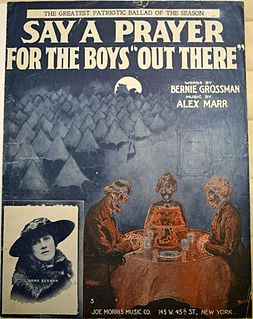
"Say a Prayer for the Boys "Out There"" is a World War I era song released in 1917. Bernie Grossman wrote the lyrics. Alex Marr composed the music. It was published by Joe Morris Music, Co. of New York, New York. The sheet music cover was designed by the Starmer Brothers. It features a family praying at the dinner table. Behind them is a sentry guarding a campground of tents. There is an inset photo on the left side that varies per edition. The song was written for both voice and piano.
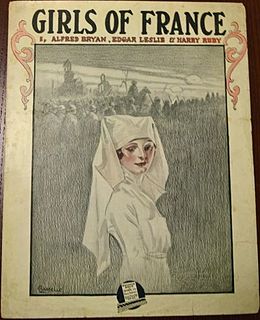
"Girls of France" is a World War I era song released in 1917. Al Bryan and Edgar Leslie wrote the lyrics. Harry Ruby composed the music. The song was published by Waterson, Berlin & Snyder Co. of New York, New York. Artist Albert Wilfred Barbelle designed the sheet music cover. It features a nurse in the foreground, and soldiers marching behind her. It was written for both voice and piano.
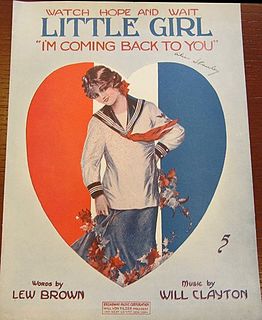
Watch, Hope and Wait Little Girl: I'm Coming Back To You is a World War I song written by Lew Brown, and composed by Will Clayton. The song was first published in 1918 by Broadway Music Co. in New York, NY. The sheet music cover was designed by E.E. Walton, and features a young woman in a heart of red, white, and blue, flowers are gathered at her knees
References
- 1 2 Paas, John R. (2014). America Sings of War:American Sheet Music from World War I. Wiesbaden: Otto Harrassowitz GmbH & Co. KG. p. 15.
- ↑ Parker, Bernard S. (2007). World War I Sheet Music. Jefferson: McFarland & Company Inc., Publishers. pp. 244–245.
- 1 2 "Common Welfare". The Survey. 33 (8): 186–187. November 21, 1914. Retrieved September 1, 2019.
- ↑ Annual Reports of the Navy Department for the Fiscal Year 1914: Report of the Secretary of the Navy. Washington: United States Government Printing Office. 1915. p. 46. Retrieved August 12, 2019.
- ↑ Klekowski, Edward J.; Klekowski, Libby (2014). Americans in Occupied Belgium, 1914-1918: Accounts of the War from Journalists, Tourists, Troops and Medical Staff. Jefferson, NC: McFarland. pp. 143–44.